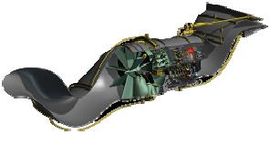
The Adaptive Versatile Engine Technology (ADVENT) program was an aircraft engine development program run by the United States Air Force with the goal of developing an efficient adaptive cycle, or variable cycle engine for next generation military aircraft; initial demonstrators were expected to be in the 20,000 lbf (89 kN) thrust class.
In 2012 the program was succeeded by the Adaptive Engine Technology Demonstrator (AETD) program; work continued in 2016 under the Adaptive Engine Transition Program (AETP), which focused on developing and testing a 45,000 lbf (200 kN) thrust class adaptive cycle engine for potential F-35 re-engining. A subsequent Next Generation Adaptive Propulsion (NGAP) program was also launched for a related 35,000–40,000 lbf (156–178 kN) thrust class engine to power the Next Generation Air Dominance crewed fighter aircraft.
Objective
The objective of ADVENT is to develop an engine that is optimized for several design points, rather than the traditional single point. Instead of having an engine that is designed solely for high speed (like many current fighter engines are) or for high fuel efficiency (like many current commercial engines are), the final ADVENT engine would be designed to operate at both those conditions. Specific goals include reducing average fuel consumption by 25% and reducing the temperature of cooling air produced by the engine.
Applications
The ADVENT engine was originally targeted at the Air Force's 2018 Next-Generation Bomber, but uncertainty in that program has led Rolls-Royce (RR), one of the primary developers involved with the project, to predict that the ADVENT engine will be better suited for a potential 2020 engine upgrade for the F-35 Lightning II. RR, who is partnered with GE Aviation on the embattled F136 alternate engine for the F-35, has suggested that the ADVENT development contracts are all the more reason to continue the F136, as any engine upgrade from Pratt & Whitney (makers of the F135 engine currently used in the F-35) would have to be separately funded, either internally or to additional government cost.
History
The ADVENT program is one of several related development projects being pursued under the Air Force's Versatile Affordable Advanced Turbine Engine (VAATE) program. After being announced in April 2007, Rolls-Royce and GE Aviation were awarded Phase I contracts in August 2007 to explore concepts, develop and test critical components, and begin preliminary designs of an engine.
In October 2009, Rolls-Royce was awarded the Phase II contract to continue component testing and integrate the developed technologies into a technology demonstrator engine. GE Aviation was also awarded funds to continue development of their technology demonstration core, which was unexpected as the ADVENT program had originally called for a single contractor to be selected for Phase II.
With the threat of the GE/RR F136, Pratt & Whitney has funded an adaptive fan variant of its F135, that may qualify for the follow-on Adaptive Engine Technology Development (AETD) program under the US Air Force Research Laboratory.
In 2012, GE was chosen to continue its ADVENT work into the AETD program. GE and Pratt & Whitney were selected over Rolls-Royce to continue the AETD program to mature fuel-efficient, high-thrust powerplants. Operational testing of the engine was expected to begin in 2013. Under AETD, GE had set new records with the highest demonstrated compressor and turbine temperatures. In 2017, Pratt wrapped up tests of their three stream engine with a F135 core.
In 2016, the Adaptive Engine Transition Program (AETP) was launched with the goal of developing and testing adaptive engines for the future sixth generation fighter programs, Penetrating Counter Air (PCA) or Next Generation Air Dominance (NGAD) for USAF and F/A-XX for US Navy, as well as potential re-engining of the F-35. The program assigned the new designations XA100 for General Electric's design and XA101 for Pratt & Whitney's. The next generation fighter engine would eventually become separate from the F-35 efforts due to the different optimizations required and was split off into the Next Generation Adaptive Propulsion (NGAP) program. The competing designs for NGAP are the XA102 from General Electric and XA103 from Pratt & Whitney.
See also
Related development
Related lists
References
- ^ Barr, Larine. "Air Force plans to develop revolutionary engine" Archived June 5, 2011, at the Wayback Machine. US Air Force press release, 11 April 2007, Accessed: 20 October 2009.
- ^ "Rolls-Royce Selected for ADVENT Demonstrator", Press Release, 18 Oct 2009, Accessed 20 Oct 2009.
- Trimble, Steven. "Rolls-Royce: F136 Survival is key for major F-35 engine upgrade" Flight International, 11 June 2009, Accessed: 20 Oct 2009
- Trimble, Steven. "Pratt & Whitney Loses Second Bit for USAF Technology Contracts". Flightglobal, 25 September 2007. Accessed: 20 October 2009.
- Trimble, Steve. "USAF Selects General Electric and Rolls-Royce to Continue ADVENT work". Flight International, 15 October 2009. Accessed: 20 Oct 2009.
- Majumdar, Dave. "FARNBOROUGH: Pratt to test new adaptive fan F135 variant next year." Flight International, 12 July 2012.
- Brooks, Robert. "USAF Taps GE to Develop New Jet Engines." American Machinist, 21 October 2012.
- Warwick, Graham. "Pratt In, Rolls Out, GE Stays On AFRL Advanced Engine Demo." Aviation Week, 18 September 2012.
- Clark, Colin (June 18, 2015). "GE Jet Sets Record; Will F-35 Get New AETD Engine?". Breaking Defense. Retrieved January 11, 2020.
- Insinna, Valerie (September 18, 2017). "Eyeing the future fighter, Pratt & Whitney hits milestone with new adaptive engine". www.defensenews.com. Sightline Media Group. Retrieved August 10, 2018.
- Trimble, Steven (July 9, 2018). "USAF starts work on defining adaptive engine for future fighter". Flight Global. Retrieved January 11, 2020.
- Tirpak, John (April 5, 2024). "Air Force Wants $1.3 Billion to Finish Design for New Fighter Engine". Air and Space Forces Magazine.